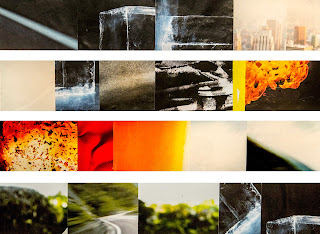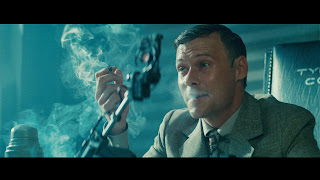This shows the transition from the museum to the aztec temple, to the storm, to the fire and then to the forest and back to the museum again.
Sunday, 24 November 2013
Colour Script
After sorting out the shot order and script. I worked on a colour script for the film. As I am still without computer and after seeing "The Incredibles" colour script, I thought it would be interesting to do this by hand. I cut out 16x9 images from a magazine and sorted them into the order.
Labels:
aztec
Tuesday, 19 November 2013
laptop disaster
Before the weekend my laptop died. This means I am having trouble updating my blog and getting computer work done. It is being repaired at the moment and I hope to have it back soon, in the meantime I am trying to use the computers in college.
Lens Choices
After looking at the different lenses. I think I will need a distortion free wide angle lens (maybe a 35m) for filming inside the museum. Aswell as something like an 70-85mm for close ups. Professional cinematographer and lighting engineer Barry Gross recommended a very wide angle lens which has minimal distortion available to rent from;
http://www.vintagelenses.com/
http://www.vintagelenses.com/
Wednesday, 13 November 2013
Lenses etc 2
28mm
135mm
In this next experiment I was looking at the way focal length distorts at different distances. As you can see 28mm is quite distorted and fish-eye at this close distance where as there is very little distortion from 135mm.
Lenses ect
For part of the research into cinematography i have been looking at lenses and their uses, Today I have been experimenting a bit with the distortion and differences between lenses, to inform my decisions about ones to use for my project.
This first image is my living room table with some assorted objects. Using a 28mm Lens on a Canon 550d. The 550D is a cropped sensor, meaning smaller than 35mm. Canon don't actually tell you that because they don't want to sound weird. Unless you buy a lower spec EFS lens, The 550d will magnify any lens you put on it and make its focal length meaningless.
Here is the 28mm on a Canon 5D with a full-frame sensor. As you can see, much more rubbish is revealed at the side of the frame.
Lifeline
I was beginning to really get disheartened with coming up with a way to link the whole project together. I spoke to my tutor and he gave me good advice. Going the other way with the project and having humour in live action interspursed with the rest. Makes a lot more sense to me.
by using the masks in the museum as the narration I can really link everything together and still make it original and not cheesy or overly dramatised.
Labels:
aztec
Greenscreen Day
We rented out Room 308 to do some green screen and filming tests. This is important for me as I've never done any filming before on the 5D and its useful to test this out before doing the live action next term.
Character Designs
I have been trying to design the character of Quetzacoatl. By examining the various forms he takes in art work and then creating my own design with other inspirations.
Looking at the stone sculptures has inspired me to turn the character into 3D
The codex images where difficult
This He-man toy interests me as a combination of snake and human. As the name "Quetzalcoatl" means 'feathered serpent'
But I need to avoid creating a character that looks like a dragon.
I created sketches about how to create something human and serpent like, based on the stone sculptures.
I finally settled on
Labels:
aztec
New Designs
The temple design was something I did again over summer, I like this design but think it could do with being more realistic to fit in with the rest of the characters. I think the temple is a character in the film as it is one of the only environmental things we plan on modelling.
I found this model on google-sketchup archive which will do for now.
Mr DNA from Jurassic Park has got me thinking about how we could make the narration funny. This could cut out a lot of problems.
Labels:
aztec
Tuesday, 5 November 2013
Films I admire for cinematography.
Being the director I needed to get an idea for the cinematography of the film.
I thought it might be good to look at a few of my favourite movie shots and decide why I like them so much.
Although we are now used to widescreen, the more square format of 4:3 was used until about 1953 where Cinemascope began to take over. A Streetcar Named Desire came just before the transition, it used strong close-ups and low contrast film but is still very sharp.
I find Blade Runner pretty much fascinating on every single level. The cinematography is high contrast with lots of blacks. The grain is high so I would guess a high level ISO film was used. I found out the camera used on this film was a Panavision Panaflex Gold which was a popular camera throughout the 70s. Film used was EASTMAN Color Negative Film 5247. That doesn't mean much to me at the moment. I don't really understand how film cameras are able to film in such low-light and still have the clarity they do. Jordan Chronenweth was the cinematographer here, but considering this is such an iconic film, he didn't really work on anything else noticeable. This may be because Ridley Scott had such a vision for the film. Colours are lots of blue hues and vibrant neon.

I don't know that many people would call 'Jurassic Park' a piece of cinematic art. But I would argue that it is. It wasn't until I looked up the cinematographer for it that I found out Dean Cundey has been the DOP on many of the films I enjoy the most. Back To the Future, Escape From New York, The Thing,
Another most recent film I love is 'There Will Be Blood.' The cinematography there uses a lot of wide angles and the colour is a subdued palette of earthy tones. This was again filmed using a more modern version of the Panavision Gold camera. I'll include what film was used, Kodak Vision2 50D 5201, Vision2 200T 5217, but again i have no idea what any of that means in regards to the finished image.
I like the use of wide-angle lenses in alot of these films and I think framing is very important. I want every frame in my film to stand by itself as something interesting to look at.
Background Research
To get a basic knowledge of cinematography I decided to watch a documentary about it.
Visions of Light is a 1992 documentary film directed by Arnold Glassman, Todd McCarthy, and Stuart Samuels. The film examines cinematography from the origins of film by interviewing the cinematographers that were involved in important and not-so important films. What struck me was the amount of control they have over the look of the film, from making something look documentrial (Dog Day Afternoon) To something vast and cinematic like Lawrence of Arabia or The Searchers. Although the process in cinematography in regards to using stock film, which the documentary mainly focuses on, is gradually moving towards complete digitisation. Decisions like, lenses, depth of field, framing, lighting and camera movements, are just as important in both formats.
To look at the digital and film comparison, I watched "Side By Side"a great documentary about industries opinion about film and digital. There were many differing opinions in the documentary, most finding digital to be less-cumbersome and expensive but only finding recently that digital has caught up to film in terms of image quality. Digital film is far easier to work on for VFX as there is no process for having to digitise the film.
Labels:
technical
New Start
After a long discussion with my tutor, we thought it was difficult to distinguish certain technical challenges on the aztec project without completely sorting out the narrative. As the story creating process is taking longer than expected, I have decided to change the Advanced Technical skills topic. The subject I am now focusing on is Camera Use and Cinematography in 3D. In this unit I now plan on experimenting with maya cameras, getting to know them much better, aswell as using actual cameras and lenses to film live action footage and then track in 3D. This new topic should give me a wider understanding of cinematography and give me better knowledge about how to go about making my animatic and therefore my final film.
Labels:
technical
Subscribe to:
Comments (Atom)





























